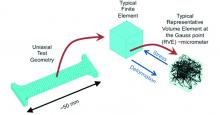Biological Sciences
Energy Storage

With the rise of energy storage applications for such things as rechargeable Lithium ion batteries and solar cells, graphene and graphene-based nanocomposites have attracted a lot of interest.
Tricuspid Valves
Tricuspid valve surgery is a common heart valve procedure in the United States, but it is one with poor long-term outcomes. In fact, studies show that up to 45 percent of those who receive tricuspid valve surgery suffer a recurrence of problems, in some cases as early seven years after surgery. In one-third of the cases, a second operation is required.
RNA Signaling
The rise of antibiotic resistance among common infectious bacteria is a worrisome health threat that has many scientists looking for a solution. Jennifer Hines, Ph.D., professor of chemistry and biochemistry at Ohio University, is one of the few looking to ribonucleic acid (RNA) structures for new drug discovery.
Drag Reduction
Bharat Bhushan, Ph.D., was on sabbatical at Ecole polytechnique federale de Lausanne, Switzerland in 2005 when a transformation began.
After reading an article in a trade magazine on the lotus leaf’s water repellant properties, Bhushan’s industrial research launched down a greener, livelier new path.







